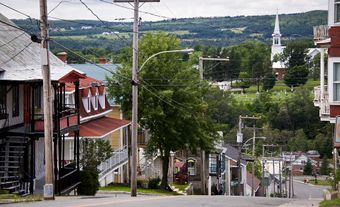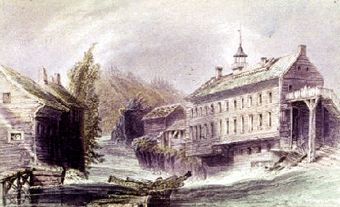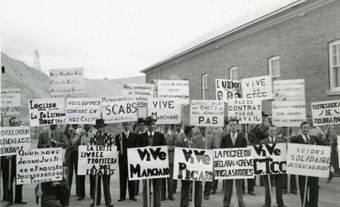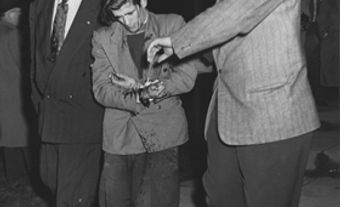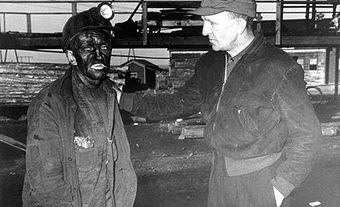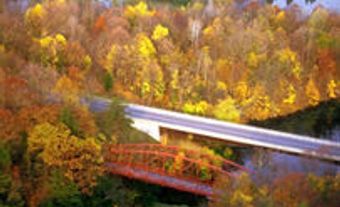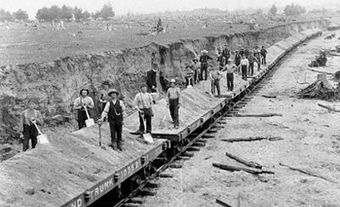Val-des-Sources, Quebec, incorporated as a village in 1899 and as a town in 1937, population 7,088 (2021 census), 6,786 (2016 census). The town of Val-des-Sources is located in the Eastern Townships region, 53 km north of Sherbrooke and 58 km southeast of Drummondville. Originally called Asbestos, the town was named after the mineral mined there from 1881 to 2011. During that time, Asbestos produced much of the world’s supply of the asbestos mineral, which is now banned in many countries because of its negative health effects. Asbestos was renamed Val-des-Sources in December 2020. Val-des-Sources is located on ancestral Abenaki lands. The land is unceded and is considered Indigenous territory.
History
Before European colonization, the Abenaki inhabited the Eastern Townships region. They partnered with the French in the fur trade and allied with them against the British. Within a few decades of contact with Europeans, warfare and exposure to diseases had decimated the area’s Abenaki population. British and Loyalist settlement of the Eastern Townships began after the British Conquest of 1760.
Evan Williams, a Welsh miner, discovered an asbestos deposit in 1879 on land owned by Charles Webb. Charles Webb and William Jeffrey began mining the site in 1881. The British Asbestos and Asbestic Company bought the Jeffrey Mine in 1897. A community grew around the developing mine in the 1890s; it was incorporated as a village in 1899. During the First World War, the mine came under the control of American investors H.W. Johns-Manville Company. Johns-Manville would run the mine until the company’s bankruptcy in 1983.

Asbestos Strike of 1949
On 14 February 1949, 5,000 asbestos miners in Asbestos and Thetford Mines began a strike that lasted almost five months. It was one of the most violent labour conflicts in Quebec’s history. The Catholic Church sided with the miners against the provincial government and Johns-Manville. The Asbestos Strike was a turning point in Quebec’s social history, helping to lay the groundwork for the Quiet Revolution.
Development
The mine’s steady growth during the Johns-Manville era transformed the town’s landscape. Some streets and homes were torn down or moved between 1975 and 1980 as the mine encroached upon the town. Rocks thrown from the pit during blasting made it unsafe to live in certain parts of town (see also Mining Safety and Health).
From 1983 to 2000, JM Asbestos Inc., a company started by former executives of Johns-Manville, ran the mine. The company operated under the name Jeffrey Mine Inc. from 2000 until the mine closed in 2012.
With a depth of 350 m and an area of 6 km2, the Jeffrey Mine was the largest open-face asbestos mine in the world. The mill had an annual capacity of more than 600 million kg. However, production was much lower in the later years due to health problems such as asbestosis, mesothelioma (a form of lung cancer) and other cancers caused by breathing in asbestos fibres (see also Occupational Diseases). Awareness of these dangers, and the resulting bans on asbestos in many countries, led to the Jeffrey Mine’s closure in 2012. In 2018, Canada introduced its own ban on the sale and use of asbestos and asbestos products.

Economy
Since the demise of the Jeffrey Mine, one company, Alliance Magnesium, has worked to extract metals from the tailings (debris) left over from asbestos mining. But the town has also focused on growth in other industries. These include machining, assembly, metal processing, food processing and eco-friendly materials. Transportation is a longstanding industry in Asbestos, given the town’s proximity to the US border.
Name Change
In October 2020, a vote was organized among residents of Asbestos to choose between six potential new names for the town. After three rounds of voting, Val-des-Sources received a majority of 51.5 per cent of votes. In December 2020, the town was renamed from Asbestos to Val-des-Sources. This was in spite of a petition of around 1,000 signatures opposing the name change.

 Share on Facebook
Share on Facebook Share on X
Share on X Share by Email
Share by Email Share on Google Classroom
Share on Google Classroom
